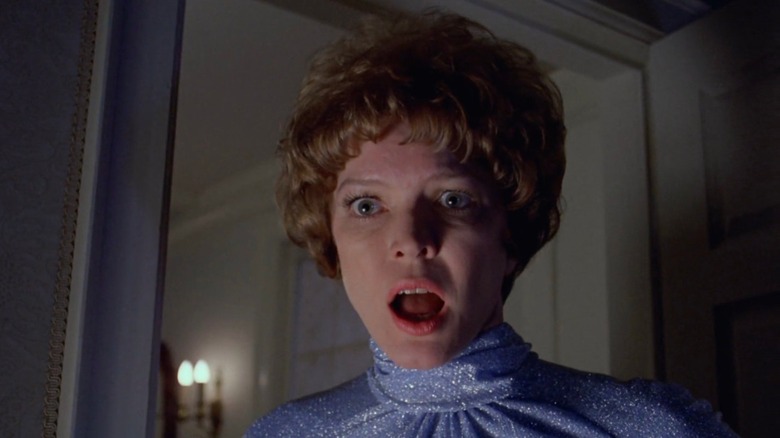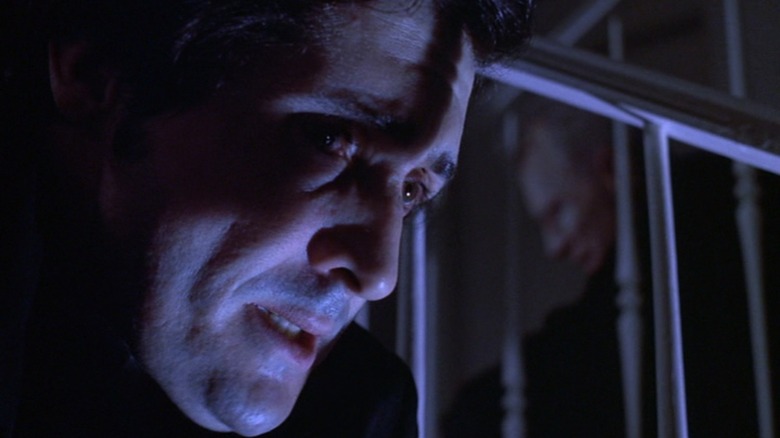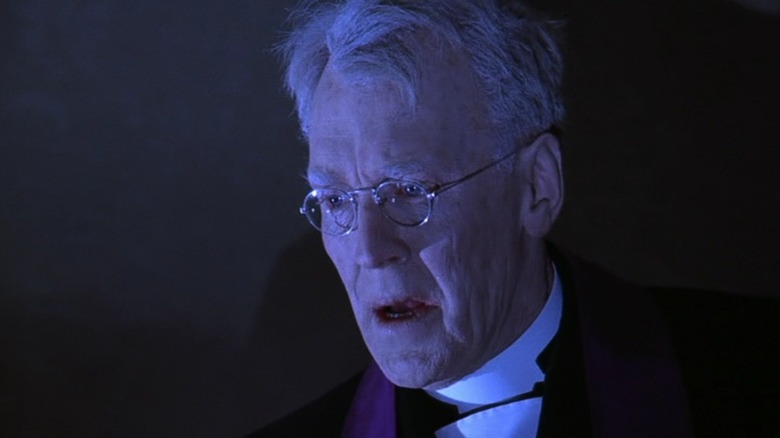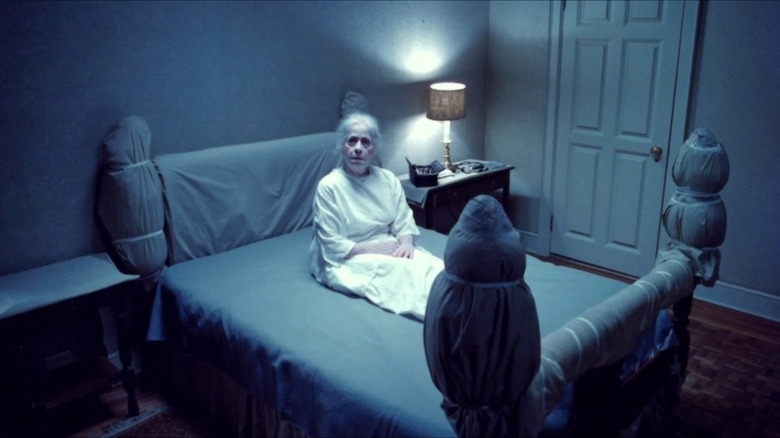Modern Horror Cinema Wouldn't Exist Without The Exorcist Or William Friedkin
William Friedkin's demonic possession film "The Exorcist," based on the novel by William Peter Blatty, cause a sensation when it was first released in 1973. It took place in Georgetown, Washington DC, an upscale college town, and depicted the life of a young girl named Regan (Linda Blair) as she became increasingly ill and erratic. She began contorting her body at random intervals and screaming obscenities at adults in a deep, unusual voice. No doctors could find out what was wrong with her. Regan's illnesses were marked by some eerie coincidences. She had recently, just for fun, begun having conversations with a spirit named Captain Howdy via an Ouija board. A local church was also vandalized, their Virgin Mary statue given outsized genitalia.
Also, a faraway priest named Father Merrin (Max Von Sydow) discovered a strange demonic statue in an archaeological dig in Iraq. As Hamlet might say, time is out of joint.
Eventually, Regan's mom Chris (Ellen Burstyn) finds that the girl's illness might be connected to her reading about the Devil. Chris, an atheist, at the end of her rope, hires a priest named Father Karras (Jason Miller), also experiencing a crisis of faith, to investigate. To the audience, it slowly becomes clear that Regan is bodily possessed by some evil, supernatural force. For Karras, it's a matter of proving the supernatural.
It's not a very uplifting movie. The Divine does exist, it posits, but it's death and evil the human world touches. There is an intense melancholy to "The Exorcist" hiding in its many quiet moments. God is real, but the world is breaking down.
"The Exorcist" was a massive, massive hit, and more or less launched a genre. It has become one of the fulcrums of cinema, and a guidepost within American culture at large.
The demon is a liar
Horror has remained, throughout cinema history, the most versatile and long-lived genre. It is often presented as cheap and lascivious, considered a genre for horny, bloodthirsty drive-in teens and low-brow, death-hungry thrillseekers. After all, it doesn't take a lot of sophisticated thought or advanced filmmaking acumen to orchestrate a good jumpscare or a disgusting gore tableau. It is just as often presented as an earnest, essaying, often philosophical genre, delving into the deepest fears held by civilization. Sometimes it's the fear of being stabbed by a maniac. Sometimes, though, it's the existential fear that comes with religious doubt.
"The Exorcist" is more firmly in the latter camp, often pausing for moments of relatable human panic in the midst of the supernatural demonic shenanigans. "Why this girl?" Father Karras asks Father Merrin in a moment of fear and emptiness. Why has a demon, perhaps Satan Himself, chosen an upper-class white girl in America to harm? Father Merrin is unsure, but says "I think the point is to make us despair." The Devil doesn't want us to be violent, but to live without hope. "To see ourselves as ... animal and ugly. To make us reject the possibility that God could love us." These sorts of theological discussions were rarely had in horror movies up to that point.
"The Exorcist" (along with "Rosemary's Baby" five years before) made horror more acceptably mature for a filmgoing public. In the years that followed, horror films were granted bigger budgets, and the supernatural invaded upper-class suburbia. "The Omen," "The Sentinel," and "The Amityville Horror" were all big hits. One should also note the slew of cheap "Exorcist" knockoffs that instantly flooded theaters. Maybe two-thirds of the Italian film industry instantly became dedicated to demonic thrillers.
I think the point is to make us despair
But there had been "adult" horror films plenty of times in the past; a horror film for adults was hardly novel. So what made "The Exorcist" stand out? It seems that two notions are at work:
Firstly, director Friedkin lent "The Exorcist" an uncanny sense of utter authenticity. It may be about the supernatural but, like in Blatty's original book, doubt underpins everything. Even when Regan magically opens drawers with her mind, or the words "HELP ME" appear in raised ridges on her stomach, there could be a medical precedent. Even as it becomes increasingly clear to the audience that the Devil is afoot, Father Karras keeps a grounded, faithless, scientific eye on the matter. On the National Center for Biotechnology Information website, author Amy C. Chambers pointed out that Friedkin wisely consulted both priests and doctors on the film's content, wanting to make sure he accurately depicted both the body and the soul. Friedkin famously included the names of his experts in the press kids for "The Exorcist," a practice previously unheard of. That layer of professional expertise gave "The Exorcist" a dimension of folk reality. This was a fictional movie, but, golly, these things could really happen.
Nine people also died during the film's production, giving "The Exorcist" a notorious sense of being cursed. The "Exorcist" haunting is talked about at length in the excellent Shudder documentary series "Cursed Films." Friedkin's authenticity led to some adverse audience reactions. Some people are said to have lost their faith, while others seem to have found it. Ever since the film's release, claims of demonic possession have steadily increased. Make of that fact what you will.
Friedkin likely didn't intend to evoke demonic panic, but he did it.
Why you do this to me?
The other factor that made "The Exorcist" stand out was its timing. The film came at the beginning of the 1970s when the Vietnam War was still raging and protests were common. Hollywood was collapsing under the weight of increasingly expensive and idiotic blockbusters (sound familiar?) and darker, franker, more intense cinema was coming into vogue. The Watergate scandal was in full swing, and many were losing faith in previously stolid institutions. It was a time of doubt and political turmoil.
"The Exorcist" may have been bleak in its belief in Actual Evil, but it also sneakily upheld a lot of traditional viewpoints. Religion, it argued, had a lot to offer an ailing public, specifically the mannered and ostentatious rituals of Roman Catholicism. The character of Chris is an actress, and she is acting in a film that features a protest scene. Chris' character takes a megaphone and argues that protest is not helpful. Institutional changes have to come from within. Some have even noted that "The Exorcist" upholds old-fashioned gender roles, depicting as it does brave chaste men rescuing the "honor" of a young woman from a masculine presence. Chris is a rich, interesting character and Ellen Burstyn is excellent, but she's not the one performing the exorcism.
But then, "The Exorcist" also argues that evil can infiltrate anywhere. The Traditional System may have won this time, but evil will persist. No matter what you believed in the tumult of 1973, "The Exorcist" reinforced it.
"The Exorcist," through its many releases, has made $428 million worldwide. It hit a nerve that we've been poking at ever since. "The Exorcist: Believer" is due in theaters on October 23, 2023.
Friedkin let us know, in no uncertain terms, that the Devil will always be lurking.



